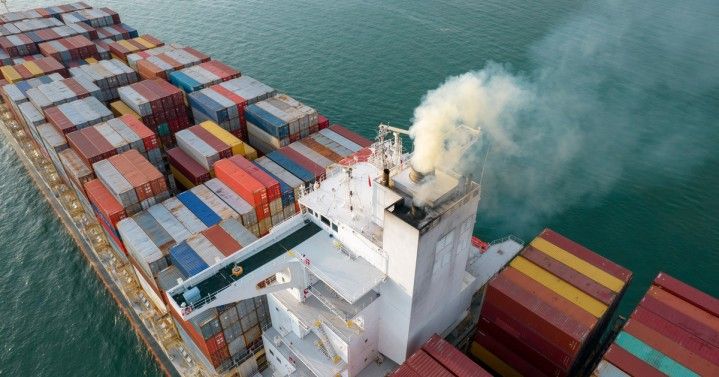
What Are Scope 1, 2 & 3 Emissions and What Should BCOs and Forwarders Know?
Generations of Americans are familiar with Smokey the Bear’s infamous catch-phrase, “Only you can prevent forest fires.” Since 1944, this campaign by the U.S. Forest Service reminded Americans that self awareness is crucial for preventing wildfires. The sustainability movement has followed suit in bringing awareness to people worldwide of their role in damaging the environment.
How a Rise in E-Commerce, Online Shopping, and Same/Next-Day Shipping Got Us to Where We Are Now
In 2019, e-commerce arose as a new primary way for consumers to make purchases. Experts suspect that by 2025, the e-commerce industry will expand by $1 trillion. Meanwhile, consumers are increasingly interested in supporting eco-friendly initiatives by purchasing from eco-friendly businesses.
In 2020, Forbes released an article discussing the paradox of consumers’ sustainability priorities, saying “consumers increasingly care more about sustainable business practices, with 42% having browsed or purchased from physical second-hand, thrift or consignment shops, and 47% saying they actively focus on buying fewer, better things. The top three requirements for e-commerce websites are free shipping (58%), free returns (46.75%), and two-day delivery (30.39%).” As BCOs and forwarders continue to work with those in the e-commerce sector, decision-makers need to understand their full impact on the environment (tracking scope 1, 2, and 3 GHG emissions) and how that will play into consumer interest.
Customers Make Decisions Based on Sustainability Practices and Protocols
To properly track the ebb and flow of customer opinion, Sifted surveyed 500 people to learn how much eco-shipping truly matters. 79% of their respondents indicated that they are currently researching eco-friendly practices. Some of their other significant findings include:
- 57% are willing to pay 10% or more to receive eco-friendly shipping or packaging.
- 66% keep sustainability practices in mind when utilizing e-commerce.
- 81% believe shipping companies should use less packaging.
- 82% would choose a delay in shipping if it were eco-friendly.
Despite the historical use of fast, free shipping, it is clear that sustainable shipping has become a priority to customers. Supply chain professionals can follow their customer’s lead by prioritizing the calculation of scope 1, 2, and 3 GHG emissions.
What Are Scope 1, 2, and 3 Emissions?
When businesses track their contribution to greenhouse gases, the data is labeled as either scope 1, 2, and 3 GHG emissions. These scopes are defined as follows:
- Scope 1 – Emissions caused directly by company assets and resources. Within scope 1, GHG emissions fall under the additional categories of stationary, mobile, fugitive, or process emissions. Scope 1 emissions must be reported and include the emissions from building heaters (stationary), vehicles (mobile), air conditioning elements (fugitive), and manufacturing (process).
- Scope 2 – Company-owned indirect emissions. Scope 2 covers all of the purchased energy sources for the company’s use and is also mandatory to report. Building electricity, refueling electric cars, and other company usages of electricity, steam, heat, and cooling fall under this category.
- Scope 3 – Indirect emissions that are not company-owned. According to the GHG Corporate Protocol, Scope 3 emissions quantification is not mandatory but it is recommended.; however, this 15-faceted category covers most of a company’s environmental impact. Those categories include company-generated waste, items purchased for company operations, transportation and distribution, in-use products, franchises, and end-of-life treatment.
Final Considerations for BCOs and Forwarders When Looking at Emission Control Measures and Guidelines
Learning about scope 1, 2, and 3 GHG emissions might cause discomfort for those responsible for transporting freight. There are so many ways that businesses can cause more damage to the environment than good. However, just as Smokey taught American citizens that they could prevent wildfires, BCOs and forwarders can reduce their environmental impact.
Freight managers can participate in sustainability initiatives such as port and corridor cleanup plans or invest in creative energy solutions such as sail towing kites or shoreside power technology. Forwarders can choose the greenest carriers by evaluating the environmental impact of each option or retrofitting their asset equipment for electricity or natural gas. BCOs with international clients can reduce CO2 emissions from sea freight with logistic tools such as carbon-conscious voyage planning.
Get a Handle on Scope 3 Emissions and Keep up With Current Trends and Regulations by Partnering with Searoutes
Without knowing that something is broken, how can it be fixed? Decision-makers take the next step in following consumer demand for eco-friendly shipping when they invest in thoroughly reporting their scope 1, 2, and 3 GHG emissions. Although scope 3 is not required at this time, that may change as more data reveals the damage that industry has on the environment. To learn more about how to reduce scope 3 GHG emissions from a Smart Freight Centre accredited partner, book a demo with Searoutes today.